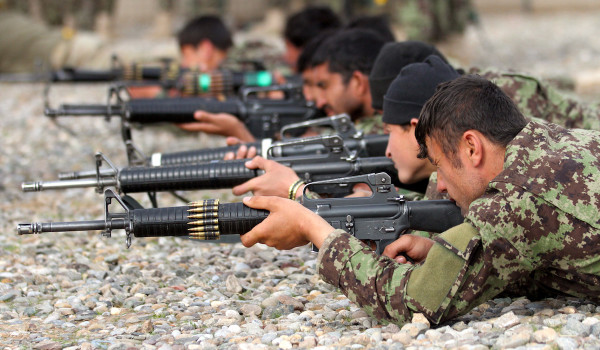

The U.S. military has spent $14.4 million on an internet-based gear and vehicle accountability system for Afghan troops and police that is effectively useless for many Afghan units which don’t have access to the internet or electricity, according to the Defense Department’s Inspector General’s office.
Afghan security forces simply are not using the system at nearly half of their local weapons and vehicles storage depots because conditions are just too austere for it to work, a recent DoD IG audit found.
Related: The Pentagon has a $700 million ammunition problem in Afghanistan
Since August 2016 the Combined Security Transition Command–Afghanistan (CSTC-A) — the command tasked with training and equipping Afghan troops and police — has awarded five contracts so that the Afghan security forces can use the Core Inventory Management System (CoreIMS) for gear and vehicle accountability.
Core IMS has significantly improved gear accountability in recent years, the audit found. Between 2016 and 2019, CSTC-A accurately recorded 98.2 percent of weapon serial numbers and 95.4 percent of vehicle serial numbers in CoreIMS using a new data-entry process implemented in August 2016, accounting for 48,507 weapons and 4,202 Class VII vehicles valued at $57.7 million and $817.9 million, respectively.
This is a huge improvement: As the DoD OIG audit notes, previously evaluations had found that CSTC-A “did not have controls in place” to effectively manage accountability for some 95,000 vehicles; “almost never” used the Afghan National Police logistics centers due to lack of Internet connectivity; and had failed to support the expansion of CoreIMS at all levels below regional supply depots.
But the Afghan security forces do not use the system at 78 of its 191 (41 percent) of their local weapons and vehicle storage sites because CSTC-A “did not fully consider the level of difficulty the challenges of the operational environment would have on the implementation of CoreIMS,” the report found — namely a lack of electricity or internet connectivity.

“CSTC‑A originally intended for the ANDSF to use CoreIMS at its national warehouses and did not intend for the ANDSF to use the system at all its logistics sites,” the audit states. “According to USD(P) officials, CoreIMS was a rudimentary system that was later enhanced, but was never intended to be used in its current capacity as the main system for the ANDSF to track weapons and vehicles.”
“Since June 2015, CSTC‑A has reported that a lack of reliable Internet and electrical connectivity throughout Afghanistan impacted the ANDSF’s ability to use electronic systems, such as CoreIMS, across all local‑level logistics sites,” the report continues. “Even after nearly 20 years of U.S. investment in Afghanistan’s infrastructure, the country continues to struggle with reliable Internet connectivity and electricity.”
Despite this, the Pentagon “continues to fund enhancements to CoreIMS even though reliable electrical power and Internet connectivity are needed to fully operate the system at all ANDSF sites,” according to the report.
The recommendation from the DoD OIG for CSTC-A are simple: Rather than relying on a system without reliable power and connectivity, you’d better task some poor lieutenant with shuffling a hard copy of your data to the closest national warehouse for entry into CoreIMS.
“Develop a process and alternate mechanism to feed weapon and vehicle information from the local sites where CoreIMS cannot be used into CoreIMS at the national warehouses, regional depots, and local sites that do use CoreIMS,” the report states. “For example, on a monthly or quarterly basis, officials from local sites without CoreIMS should be required to bring hardcopy weapon and vehicle information to the closest national warehouses, regional depots, and local sites with CoreIMS and input the information into CoreIMS.”
In the meantime, a 2016 analysis found that the Pentagon funneled some 1.45 million firearms to various security forces in Afghanistan and Iraq since the start of the Global War on Terror. It is not known how many of those ended up in local weapons armories — and how many have simply gone missing since.
Related: Afghan security forces robbed and terrorized US-funded support staff to the tune of $780K